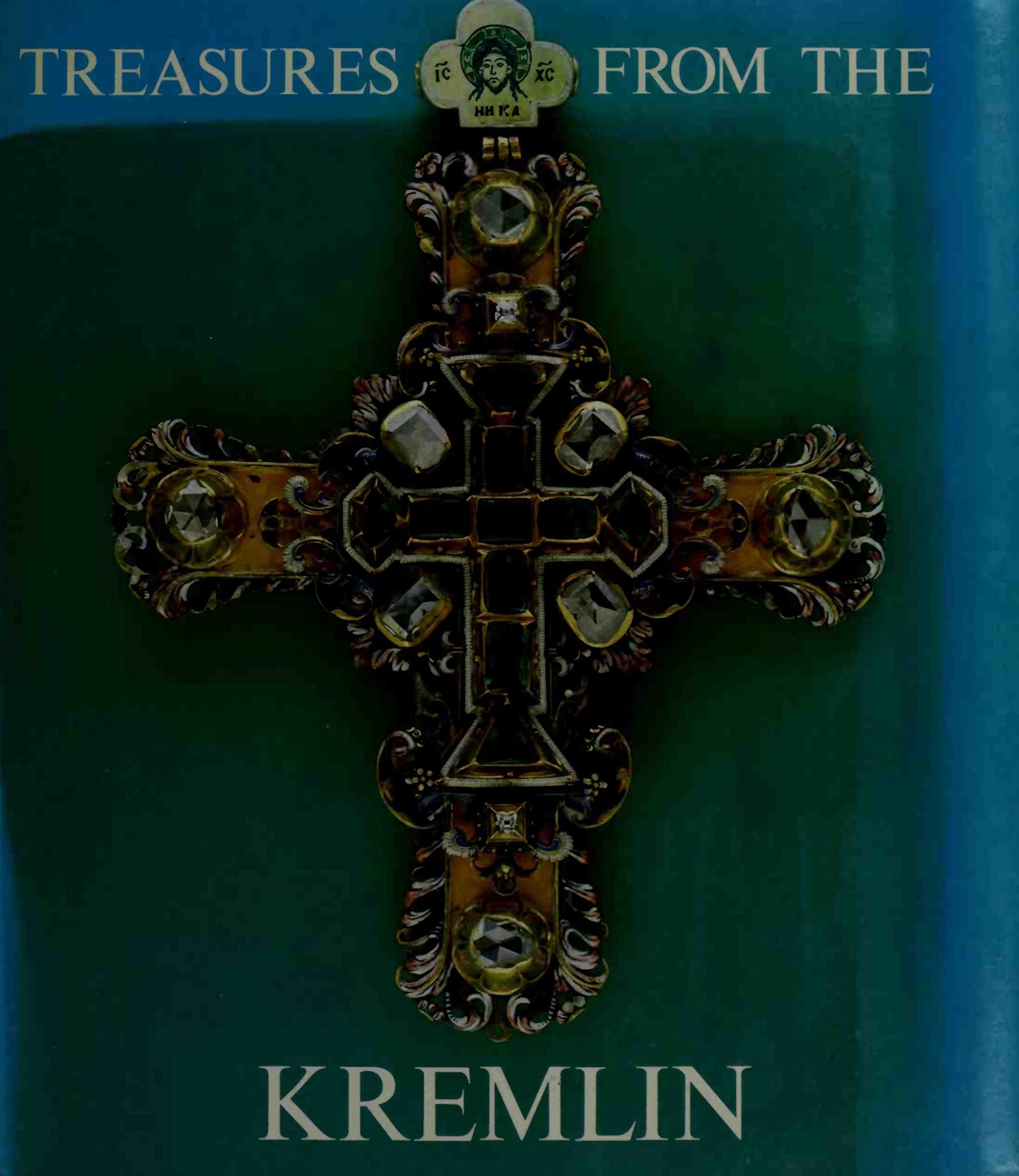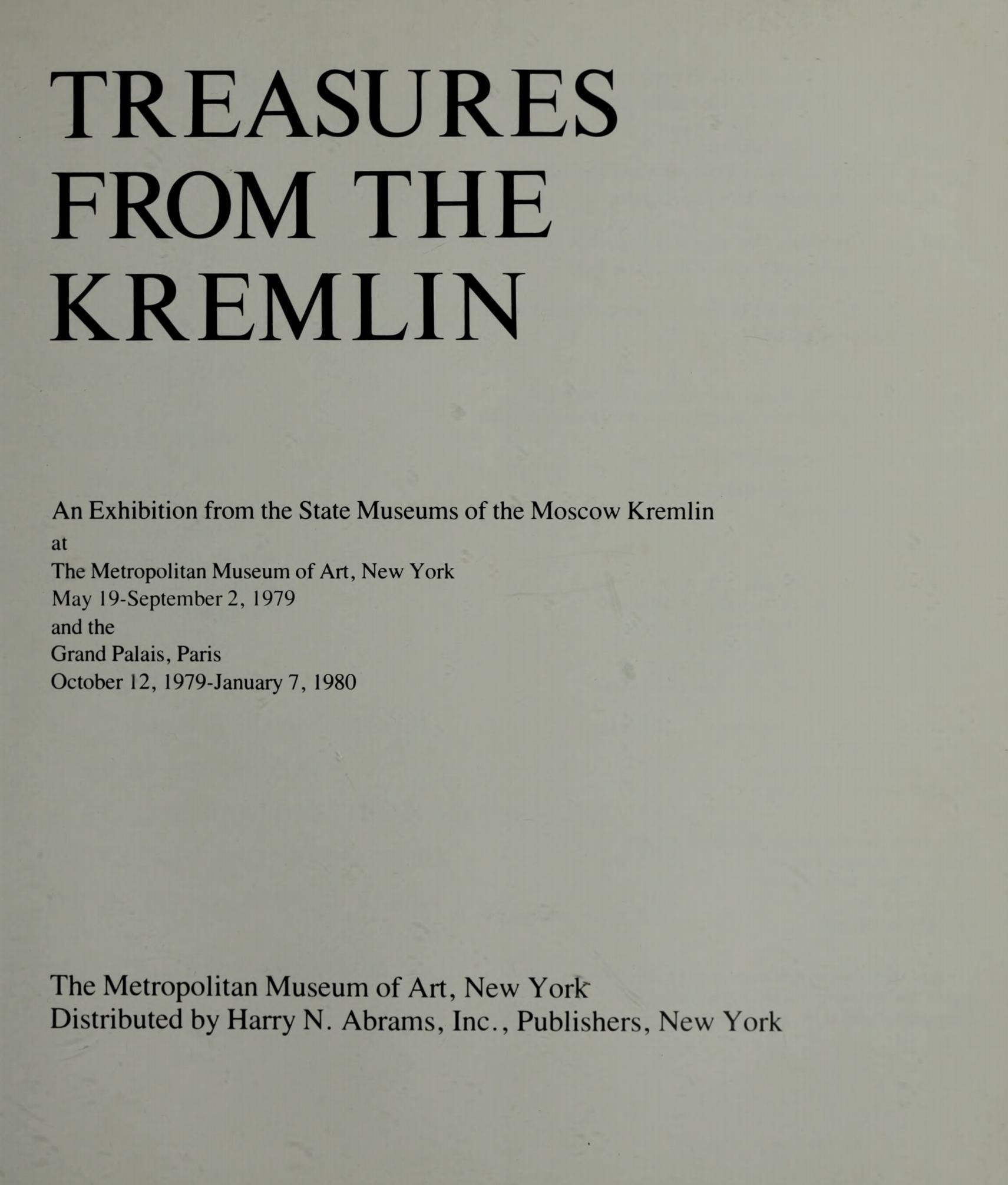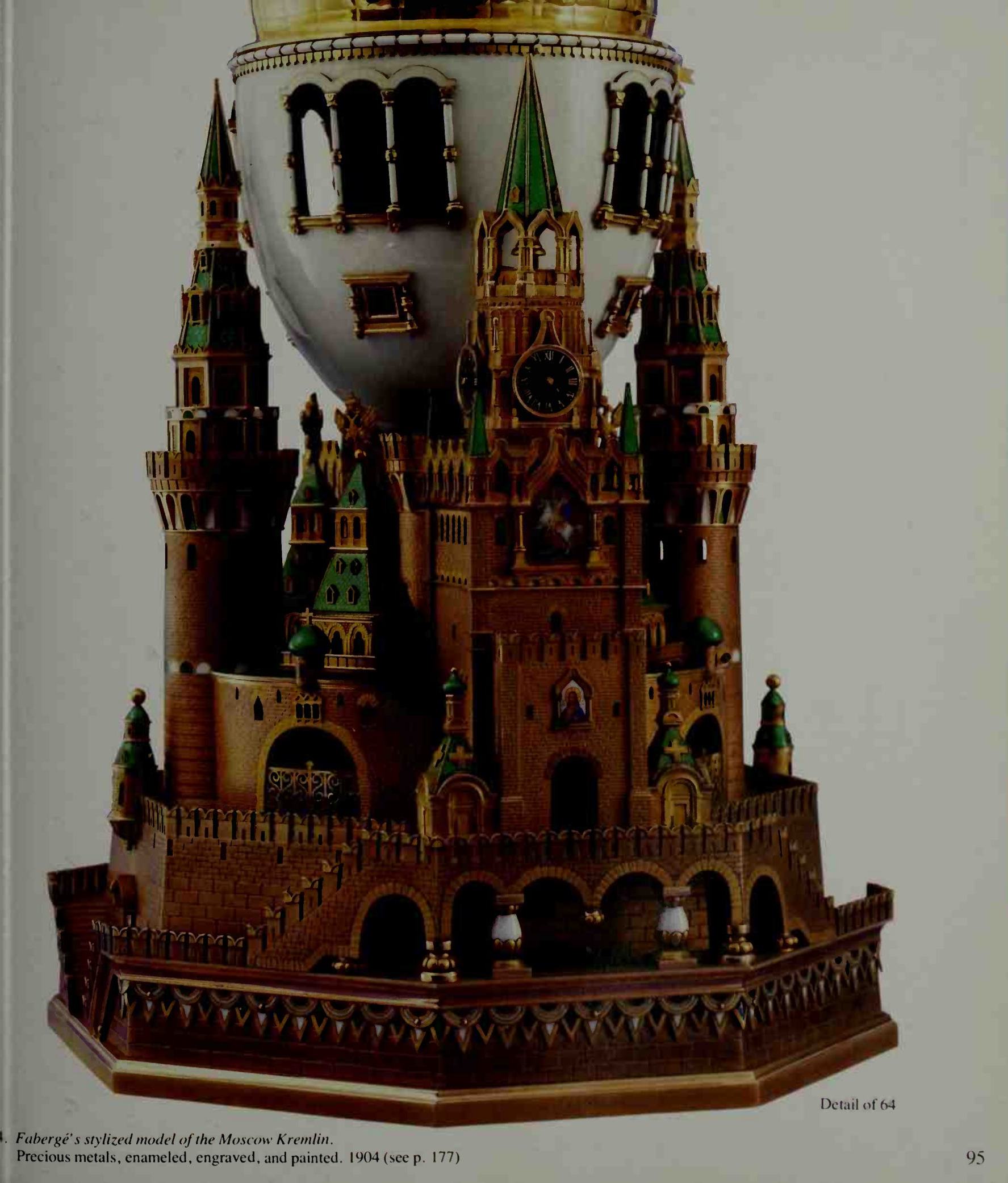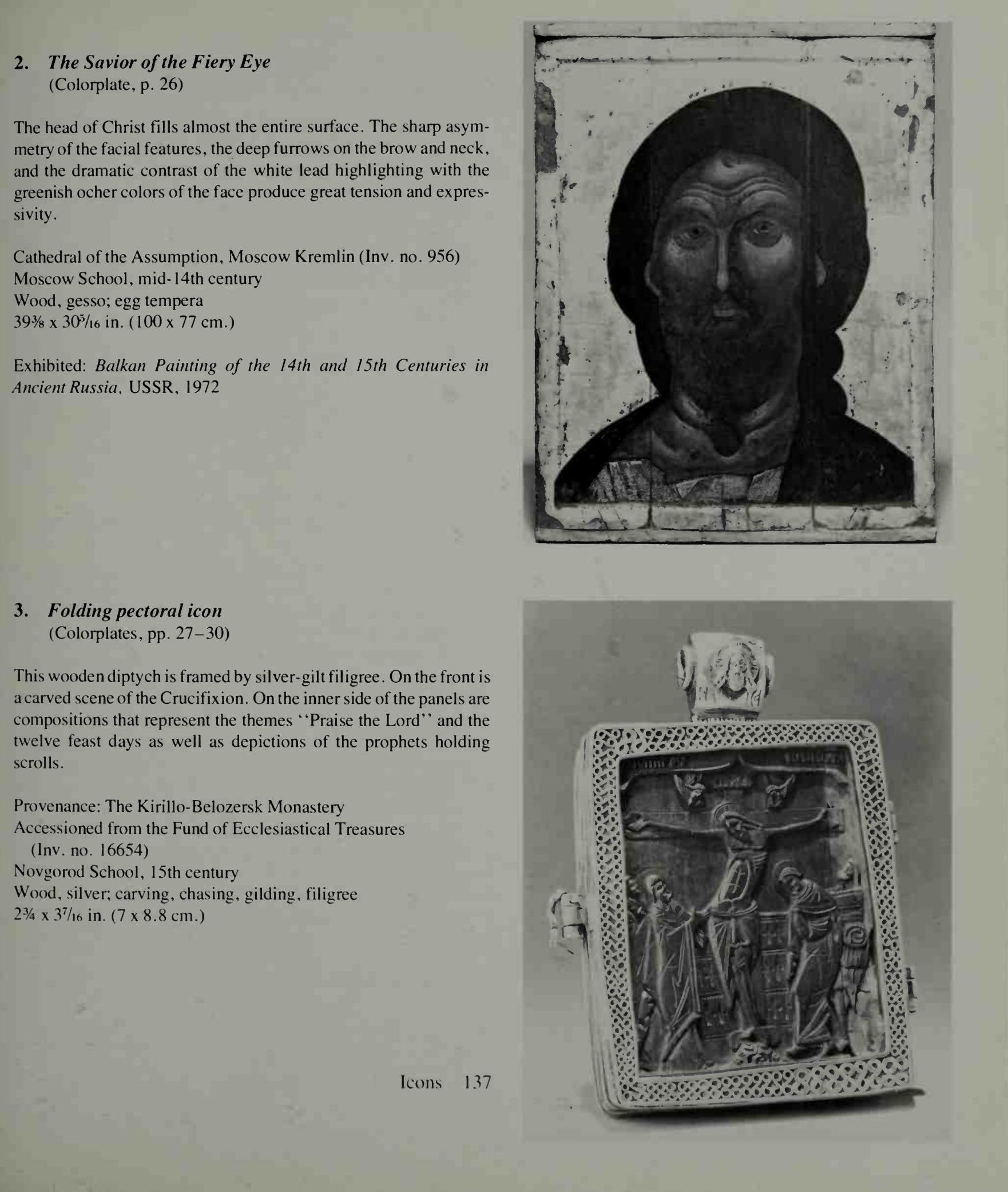|
|
Treasures from the Kremlin. — New York, 1979  Treasures from the Kremlin. — New York : Metropolitan Museum of Art, 1979. — 223 p., ill. — ISBN 0-87099-193-0 (MMA HC)
An exhibition from the State Museums of the Moscow Kremlin at the Metropolitan Museum of Art, New York, May 19–September 2, 1979, and the Grand Palais, Paris, October 12, 1979–January 7, 1980.
The Kremlin in Moscow is one of the world's greatest repositories of Russian art. Gold and silver objects of astounding beauty, arms and armor, icons, ceremonial equestrian trappings, textiles, and incomparable Russian needlework are preserved in the seven museums and churches that comprise the State Museums of the Moscow Kremlin. Magnificent objects from these, including masterworks of Western European art from the Kremlin collections, are pictured in Treasures from the Kremlin. More than two hundred illustrations, half of them reproduced in full color, reveal objects of extraordinary artistic excellence and historical significance ranging from the twelfth to the twentieth century.
Treasures from the Kremlin grew out of the great exhibition of Russian art at The Metropolitan Museum of Art in New York. Six curators of the Kremlin museums offer engrossing and authoritative essays about their individual subjects.
Starting with such fabled medieval works as the twelfth-century silver-gilt chalice of Yurii Dolgorukii, founder of Moscow, and the icon The Savior of the Fiery Eye, we move on to the sixteenth and seventeenth centuries. During this period Moscow became the political, religious, and artistic center of Russia, and the decorative arts reached the height of their splendor. Within the walls of the Kremlin, the churches and palaces blazed with an incredible profusion of artworks. From the Armory, which was the private treasury of the czars, came masterworks of the goldsmith's and the armorer's art. The damascened helmet of Ivan the Terrible's son and the coat of mail worn by Boris Godunov are illustrated in this volume.
Here too are enameled saddles; silver bridle chains, flagons, and platters; exquisite gold liturgical vessels and pearl-embroidered hangings from the Kremlin's churches. The eighteenth and nineteenth centuries are also generously represented.
A brilliant closing note comes from the atelier of the peerless Carl Faberge—an early twentieth-century representation of the Kremlin itself, executed in gold and jewels.
A selected bibliography and an index of Russian names further enhance the scope of Treasures from the Kremlin.
NOTE
The text was prepared by the chief curator, E. S. Sizov, and members of the senior research staff of the State Museums of the Moscow Kremlin: I. A. Bobrovnitskaia, E. P. Chernukha, L. M. Gavrilova, L. P. Kirillova, I. D. Kostina, S. Ya. Kovarskaia, M. N. Larchenko, G. A. Markova, M. V. Martynova, T. V. Martynova, A. S. Nasibova, I. S. Nenarokomova, A. V. Petukhova, I. F. Polynina, E. V. Shakurova, G. S. Sokolova, A. M. Terekhova, E. V. Tikhomirova, I. I. Vishnevskaia, and O. V. Zonova. The Russian text was edited by N. A. Maiasova, Deputy Director for Research.
The transliteration used is a modified version of the Library of Congress system, although the soft and hard signs of the Cyrillic have either been rendered by “i” or omitted.
FOREWORD
The exhibition Treasures from the Kremlin has been organized as part of the program of cultural exchange and cooperation between the Soviet Union and the United States and marks a significant step in the history of cultural relations between the two countries. Hitherto only individual works from the Kremlin State Museums have been displayed internationally, and these have always been merely part of larger, more general exhibitions. Now, for the first time, these museums have sent abroad an exhibition that fully represents their basic collections.
The cultural heritage of ancient Russia has excited much interest—and understandably so. The monuments of Russian art created many centuries ago still astonish us as evidence of great technical mastery and distinctive talent. Such works are inspired by great humanistic ideals and reflect a search for spiritual beauty. These enduring qualities make them relevant and particularly valuable to us today.
The Moscow Kremlin is the ancient and historic center of Russia. It was aptly called the heart of the country, since for centuries it was the axis of Russian culture. It was here that works of great historical and artistic significance were created and amassed over many centuries. After the great Socialist October Revolution of 1917 the Revolutionary Government decreed that the historic and artistic treasures of the Kremlin were to be nationalized and brought together in a single museum complex—the State Museums of the Moscow Kremlin. During the sixty years of the Soviet period, the number of Kremlin treasures has more than doubled.
The architectural monuments and examples of painting and the applied arts in the Kremlin Museums have great historic and artistic value and are an integral part of the universal cultural heritage. They embody the great artistic gifts of the Russian people; they express the national pride of their creators and inspire and nurture future generations. That is why the task of preserving and restoring these works assumed such vital, immediate importance from the moment the Soviet state was established. In October 1917 the Moscow Soviet created the Commission for the Preservation of Art and Monuments of Antiquity, whereby all cultural monuments were recorded by the state; despite severe economic hardship during those early years, funds were appropriated to renovate and refurbish endangered works. In May 1918 Lenin decreed that major repairs and restoration begin in the Kremlin, and, as a result, the unique architectural monuments, the frescoes, painted icons, and many objects of applied art were restored to their original appearance.
In recent years a general restoration plan for the Kremlin has been implemented. It goes far beyond the previous schemes and affects both the architectural complex and individual works. Concern for the preservation and restoration of historic and artistic monuments has become an official policy of the Soviet government and has found its place in the Fundamental Code of the Soviet State, the constitution of the USSR. Questions of the preservation and propagation of our cultural heritage are especially relevant today, when problems of peace, security, and international cooperation are being discussed and resolved. The extensive cultural exchanges between our two nations doubtless serve the cause of universal peace and understanding.
M. P. Tsukanov
Director, State Museums of the Moscow Kremlin
CONTENTS
Foreword
M. P. Tuskanov.. 7
Foreword
Philippe de Montebello.. 9
Introduction.. 13
Colorplates
Icons.. 24
Russian Gold and Silver.. 50
Arms and Armor.. 96
Ceremonial Equestrian Accessories.. 106
Textiles and Needlework.. 110
Western European Silver.. 124
1. Icons.. 131
2. Russian Gold and Silver.. 145
3. Arms and Armor.. 179
4. Ceremonial Equestrian Accessories.. 189
5. Textiles and Needlework.. 195
6. Western European Silver.. 205
Selected Bibliography.. 213
Index of Names.. 218
Sample Pages 
Download link (pdf, yandexdisk; 62,5 MB)
Все авторские права на данный материал сохраняются за правообладателем. Электронная версия публикуется исключительно для использования в информационных, научных, учебных или культурных целях. Любое коммерческое использование запрещено. В случае возникновения вопросов в сфере авторских прав пишите по адресу 42@tehne.com.
11 декабря 2019, 18:30
0 комментариев
|
Партнёры
|






Комментарии
Добавить комментарий